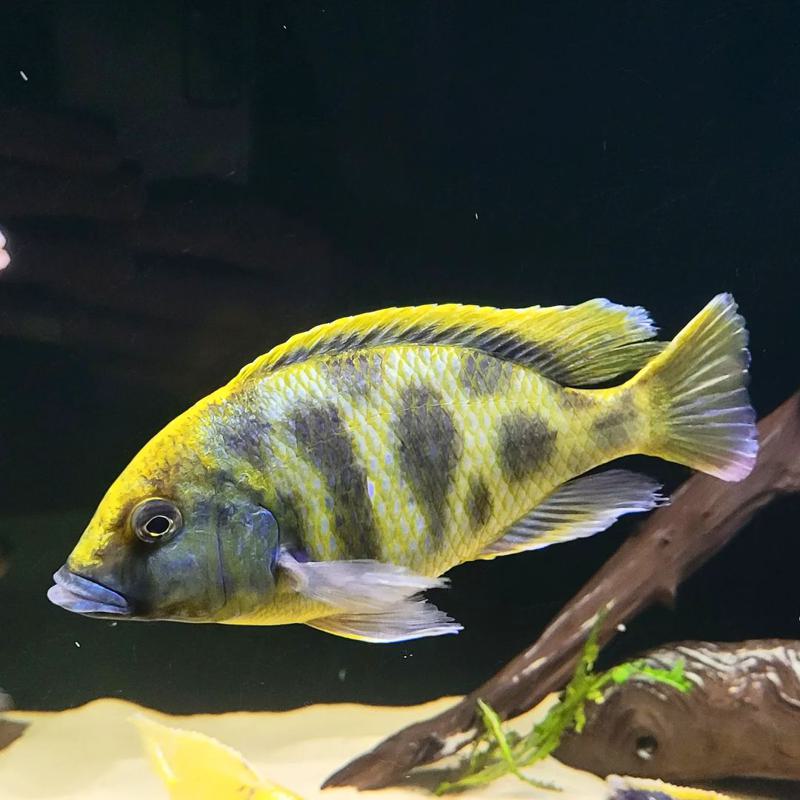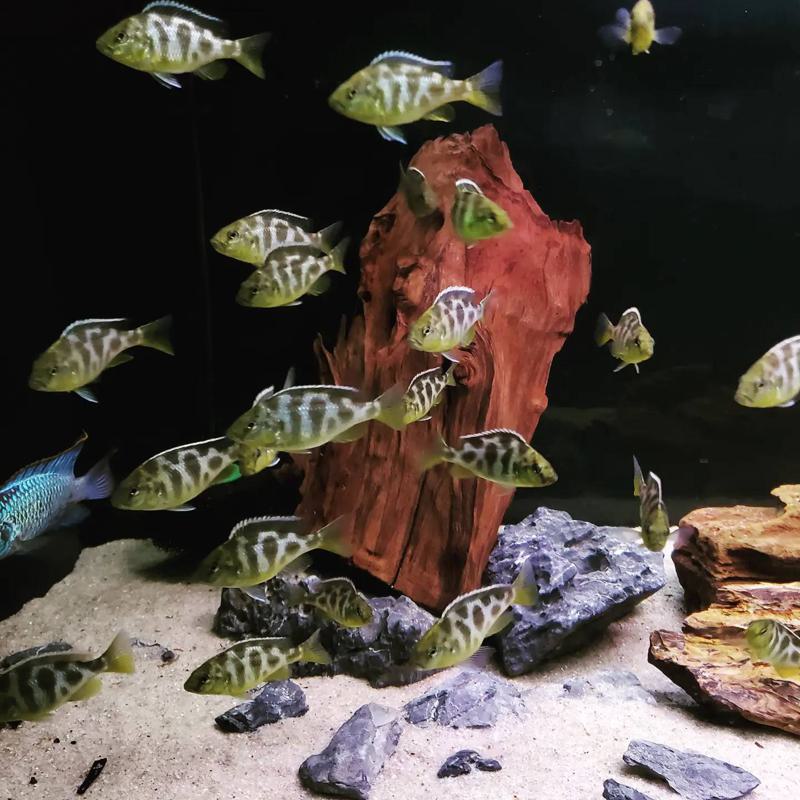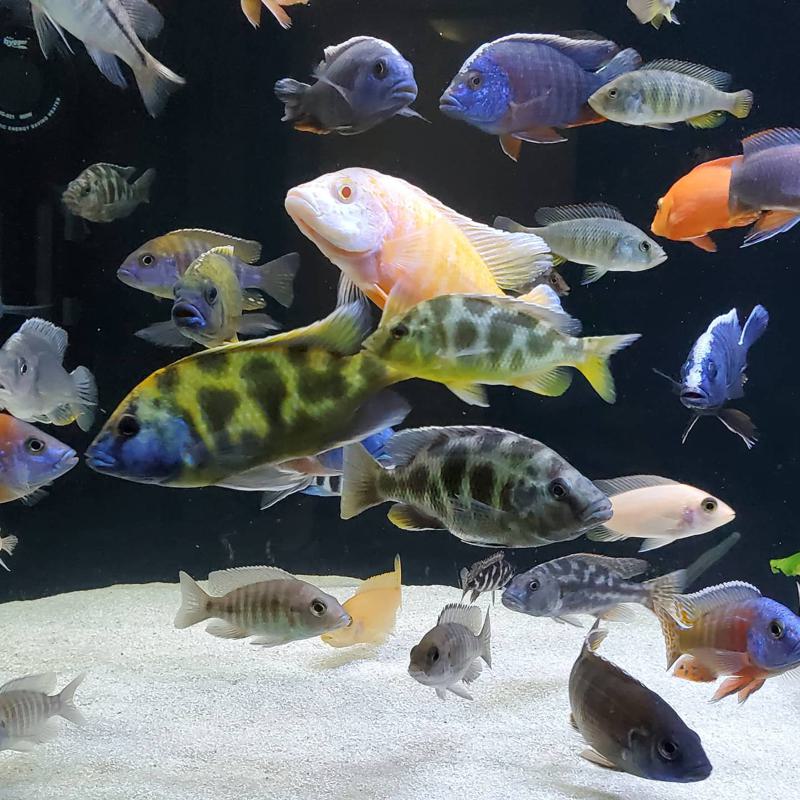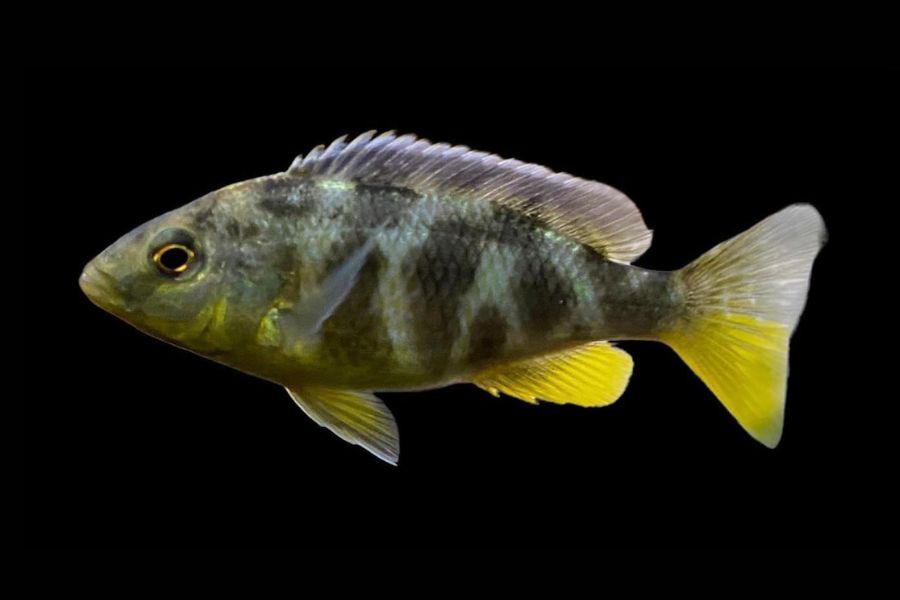The giraffe cichlid, or as it is commonly known the venustus, is a beautiful giraffe-colored fish that is readily available and easy to care for.
The giant 8-inch African cichlid can grow up to 10 inches in rare cases, making it a great fish for those looking for a bigger species.
It would be best to avoid getting the giraffe cichlids if you are inexperienced in caring for large, aggressive fish. Even though they are easy to maintain, they can be quite a challenge for someone who is just getting started.
Read on to learn all the important facts about giraffe cichlids. Get to know their origin and physical characteristics. All you need to know to carefully and successfully care for the gorgeous species is outlined in detail below.
Giraffe Cichlid Overview
| Names | Giraffe Cichlids (Nibochromis venustus)
Also known as the venustus cichlid, venustus hap, or the giraffe hap |
| Origins and Reginal Distribution | Originated from Lake Malawi in Africa
Distributed in parts of the lake that are deep from 20 – 75 feet. |
| Tank Size | 75 gallons minimum for one fish or juveniles
125 gallons minimum for one pair or a small community 200 gallons minimum for adults and breeding purposes |
| Water Hardness Conditions | Hard Water of about 3 – 25 dH |
| Ideal Tank Mates | Less aggressive, equal-sized fish. |
| Average Size | 8 – 9 inches, up to 10 inches in the ideal environment |
| Colors | Yellow base color with giraffe-like dark melanic spots |
| Lifespan | Typically, five years, but can live up to 10 years in the ideal environment |
| Breeding | Mouthbrooders |
| Diet | Carnivorous diet |
| Optimal pH levels | 7.5 – 8.4 |
| Optimal Temperature | 76 – 84 degrees Fahrenheit |
Short Summary of Giraffe Cichlids and their habitats
As part of the African cichlid community, the giraffe cichlid (Haplochromis venustus) has its roots in the lakes of East & Central Africa, particularly Lake Malawi, located between Mozambique, Tanzania, and Malawi.
It is commonly known as the venustus cichlid or the venustus hap in pet stores and by expert aquarists. A lot of people call it the giraffe hap/cichlid because of its color combination, which is similar to the patterns on a giraffe.
The natural habitat of this aggressive species is populated with lots of other haplochromine fish & African cichlids like the yellow labs, jewel cichlids, red zebra, neon blue acera, and the electric blue hap. This does not mean they coexist with all African cichlids; some are food sources for the venustus.
Lifespan
Like many cichlids, you can expect the giraffe to live for more than 4 years (typically 5 years), but they can last for up to 8 years in many conditions. Some reports have shown that cichlids can live up to 10 – 12 years, but this is in the ideal environment.
Appearance: Color & Size

So, how big do giraffe cichlids get? This is one of the intriguing aspects of the venustus. The species can grow up to 10 inches in their natural habitat, but in most captivity environments, the venustus reaches a full size of about 8 to 9 inches.
Venustus grow very fast at a similar rate to the polar blue parrot cichlids and other hardy cichlids. Many refer to it as the Oscar of the African cichlids because of its exponential growth rate.
You can expect a giraffe juvenile to be about 4 – 6 inches in about three months. Adult giraffe cichlids will sometimes reach their full size as quickly as under 9 months.
Giraffe cichlid males are also about 20% – 30% larger than their female counterparts. In an aquarium of 9-inch males, you can expect the females to be shorter than 6.5 inches. However, their size is never the best way to distinguish a giraffe cichlid male from a female.
Both sexes look alike when they are young juveniles. Their physical attributes start changing when they reach breeding maturity; the main distinction is the color changes.
At their young age, all giraffe cichlids have a yellow base color with giraffe-like dark melanic spots spread throughout the body, from the tail to the head.
As they mature, the male giraffe develops a bright, bold blue head. The yellow base color of the males also becomes more intense, with a more attractive brightness to them, which is evolutionary helpful for breeding.
Speaking of breeding, the males also lose all their dark spots in their first breeding season. These spots never come back, giving them a forever physical distinction from the females. In that regard, a mature male venustus cichlid has a bright yellow body with dark spots.
The color change is what makes the males more distinct because the females retain their base color and spots from birth to death.
Behavior
Venustus cichlids are more territorial but can be quite aggressive, as is expected of any African cichlid. They are more territorial when spawning, and it is often advisable to keep them in a separate breeding tank during pregnancy.
This makes it a harder species to care for if you are a beginner, but once you get used to it, they become the most lovable fish to own. Many hobbyists love them for their intelligence.
These giraffe cichlids are cunning and clever, a trait that is seen in how they hunt. This is one of the reasons why it is a bad idea to put the species with smaller or juvenile fish that it can hunt.
Their clever hunting tactic involves submerging themselves into the sandy substrate. The cichlid’s natural environment is filled with soft sandy substrates that make a great hiding spot.
The fish lays there motionless, awaiting its prey. Once the victim fish comes closer, the cichlid will swiftly dash out of the soft substrate without notice and pounce on the poor victim.
Giraffe Cichlid Care

To ensure you have an easy time taking care of the giraffe cichlid, pay more attention to the feeding cycle, tank mates, and use a larger than average tank.
Tank Size & Environment
The tank size is the first big concern for such a big species. At the 8-10 inches mark, you cannot go for less than 75 gallons for juveniles or a single giraffe cichlid.
The ideal tank size is 125 to 150 gallons. Here you can raise one pair of venustus or a small community to start off your stock. Please keep in mind that the bigger, the better; it is better to put the fish in a 500-gallon tank than risk raising it in a 100-gallon tank. Regardless, a tank above 200 gallons will do the job in most cases.
Consider less aggressive, equal sized fish as the ideal tank mates. If a fish can fit into the giraffe cichlid’s mouth, then you can bet it will be the cichlid’s snack sooner or later. A rule of thumb is to pick a species that is more than half the size of the venustus cichlid.
The venustus’s mouth is bigger than other Mbunas. This can be a danger to Mbunas, but it is not always the case since some Mbunas are aggressive and large too.
You can forego the trouble of raising several aggressive species together by keeping them together from a young juvenile age. This ensures they adapt together to the environment and get along.

Some of the best giraffe cichlid tank mates include:
- Malawi peacocks
- Synodontis
- Nimbochromis livingstonii
- Red empress
- Frontosa
- Blue dolphin cichlids
- Malawi haps
- Victorian haps
- Mbunas – larger ones
The male to female ratio is also crucial. Put one male with two females or more. Putting more males than females will lead to more competition, aggression, and stress.
Aggressive fish and active swimmers like the venustus tend to destroy plant life in the tanks if they have weak roots. Consider using potted plants or reducing plant life all together to prevent them from getting uprooted with the fish’s movements.
It is also good to note that they do not need much décor or a rocky environment to simulate their natural habitats. Giraffe cichlids will not be stressed so long as you have a sandy substrate and enough space for them to roam.
Water Quality & Water Parameters
As with any other species, stable water conditions are more important than achieving the right water parameters.
Most of the fish you buy in stores were bred in captivity and will have some adaptability properties that make it easier for them to live in various environments.
These are the parameters you will want to start with:
- Water Temperature: 76 – 84 degrees Fahrenheit
- pH level: 5 – 8.4
- Water hardness: about 3 – 25 dH
- Ammonia, nitrite levels: 0 PPM
Water cleanliness will need special care whenever you have an African cichlid in your tank. The venustus is a messy eater like her brothers & sisters, which means they will require strict maintenance and cleaning schedules.
Start off with a good filtrations system and about 20% weekly water changes.
Giraffe Cichlid Diet
Venustus are carnivores who prefer a high-protein diet filled with lots of meats and animal products. You run the risk of the venustus feeding on other fish if you do not feed them a meaty diet.
Some African cichlid species get picky with their diets, preferring more commercial or live products. The venustus cichlid is not like that; the fish can eat almost anything you throw at it, provided the meal fits into its carnivorous diet.
You will have to pick foods that are easily available and affordable because the venustus eat very quickly. The carnivorous cichlid pellets are among the best all-around options because they are affordable, and shops won’t be running out of stock anytime soon.
Other common meals for your venustus cichlid include:
- Smaller fish in the tank
- Veggie pellets
- Frozen bloodworms
- Carnivorous Cichlid pellet
Since the giraffes are opportunistic feeders, you should avoid overfeeding them. These fish can eat anything they come across, and you should be keen on the amount of food you can add to the tank to supplement natural food in the aquarium.
Breeding
The giraffe cichlids are maternal mouthbrooders, a fascinating process to watch. This is the same process that many African cichlids use to procreate, including the yellow labs, red zebra, and severum cichlids.
As the breeding season starts, the male venustus carve their territory on the caves, driftwood, rockwork, or décor in the tank. They become more aggressive and drive away any other male venustus that comes nearby.
A female venustus will be attracted to the male because of how it looks and the fact she has a place to lay eggs. The female cichlid will lay her eggs and then proceed to place them in her mouth immediately. The eggs are then fertilized by the male cichlid, who proceeds to ejaculate into the female’s mouth containing the eggs.
The mother holds the fertilized eggs in her mouth for about 18-21 days (pregnancy period). Both fish remain territorial and aggressive during this period to ensure the eggs hatch and develop into full free-swimming fry fish (which takes about four weeks).
The eggs will slowly hatch in the mouth of the female and be released into the water soon after.
Best parameters for giraffe cichlids to breed:
- Temperature: above 78 degrees Fahrenheit
- Diet: High protein/meat diet (good foods include fry fish and fry groundfish flakes)
- Water pH levels: Above 7.8
- Water Hardness: 3 – 25 dH
Read More:
Final Words
Many fish adapt to various water parameters because most of the ones you buy are farm-raised animals. Consistency is key when raising giraffe cichlids since they will adapt to different environments.
However, keep in mind that the fish will yield different results from what you would expect in the wild. But that is not necessarily a bad outcome.
